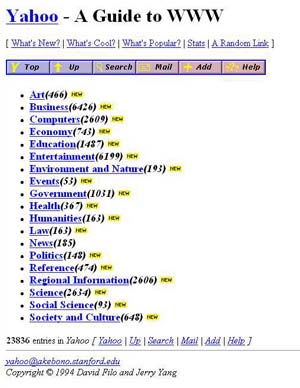
Stanford WWW Workshop
Stanford Computer Forum
September 20-21, 1994
Session 1: Web structure
Session 2: Browsers and presentation
Session 3: Social/organizational aspects
Schedule for Stanford WWW Workshop
Stanford Computer Forum
September 20-21, 1994
Tuesday, Sept. 20:
8:00 - Continental Breakfast
8:45 - Welcome and introduction
9:00 - Session 1
10:30 - Break
11:00 - Discussions
12:00 - lunch
2:00 - Session 2
3:30 - Break
4:00 - Discussions
5:00 - Informal reception
Wednesday, September 21
8:30 - Continental Breakfast
9:00 - Session 3
10:30 Break
11:00 Discussions
12:00 Planning for bird-of-a-feather sessions in the afternoon
12:30 Lunch break
Wed. p.m.: Open schedule with meeting rooms made available
In addition to these talks, we will have demonstrations of a number of Web-based systems being developed or used at Stanford. We will have number of workstations available for participants to browse the web and follow up on information resources mentioned in the sessions.
Last updated Sept. 19, 1994
Readings for Stanford WWW Workshop
Stanford Computer Forum
September 20-21, 1994
This information was prepared for participants in the WorldWideWeb Workshop. It
is intended as a starting point for further web exploration, and is not comprehensive
or definitive (most information on the Web isn't!).
WWW (The World Wide Web)
Brief executive summary - A short introduction to the Web by Tim Berners-Lee, then at CERN, now at MIT, the primary originator of the Web.
An illustrated talk - An online seminar by Berners-Lee on the World-Wide Web (W3). It gives an overview of W3 for those to whom it is new, including a review of the current status of software, and then mentions some plans for the future.
Guide to Cyberspace - Kevin Hughes from EIT wrote this guide (last update, May 1994). It offers a nice introduction to the Web's conceptual structure, to hypermedia, to Mosaic, to HTML and URLs (Uniform Resource Locators), and to the current state of the Web.
World Wide Web FAQ (Frequently Asked Questions) - This page has many pointers to detailed information, and the high-level information that it provides is fairly useful. It includes a short comparison of WWW, Gopher, and WAIS.
World-Wide Web Consortium: A Short Prospectus - The W3O (WWW Organization) is a consortium located at MIT, in collaboration with CERN, which is attempting to play a central role in standardizing and promoting the Web, as the X-Consortium at MIT did with X-Windows.
HTML (The HyperText Markup Language)
A beginners guide to HTML - This is a primer for producing documents in HTML, the markup language used by the World Wide Web.
The official HTML specification - There is much debate over just what "official" means on the Web. The emergence of the WW W consortium may help. For the moment, files produced at CERN (such as this one) are more official than others.
HTML Description - The abstract for the current HTML specification by Dan Connolly (July 1994). It has links to the specification itself (highly detailed), and the abstract itself is informative.
Technical specs for HTML - Detailed Technical specs for those interested in knowing what is really going on.
HTML+ ( or HTML 3, as it is now known) Covers the important elements that will be introduced in planned new versions
SGML (the Standard Generalized Markup Language)
A description of SGML - SGML is the basis for HTML (the Hyper Text Markup Language).
SGML FAQ - This article contains answers to questions that are frequently posted to the news group comp.text.sgml, it is intended for newcomers to the list and SGML beginners.
HTTP (The Hypertext Transfer Protocol)
HTTP technical description - HTTP is a protocol with the lightness and speed necessary for a distributed collaborative hypermedia information system. It is a generic stateless object-oriented protocol, which may be used for many similar tasks such as name servers, and distributed object-oriented systems, by extending the commands, or "methods", used. A feature if HTTP is the negotiation of data representation, allowing systems to be built independently of the development of new advanced representations.
Secure HTTP - Proposal for standards for a version of HTTP that provides security through cryptographic techniques.
Searching
CUSI - Search everything - A metaindex that lets you get to a lot of other indexes of what is on the Web.
The Internet Computer Index - More of the same including a small sample of what kind of stuff is available for ftp'ing on the web broken down by computer type.
Some interesting things to look at
The Virtual Tourist - A nice way of looking at information from a "World-Wide" perspective and shows the use of image maps.
The World-Wide Web Virtual Library: Subject Catalogue - An ambitious attempt by Arthur Secret at Cern, and volunteers, to provide a hierarchical subject catalog of what is on the web.
PLANET EARTH HOME PAGE - Another interesting way of approaching a lot of information, much of it graphical and geographical.
Yahoo page - An ad hoc attempt by some graduate students at Stanford to maintain a hierarchical listing of "cool stuff" on the net.

GNN Home Page (Global Network Navigator) - The first web-based commercial magazine.
The InterNIC InfoGuide Home Page - Information about the Internet and guides to it (including a server that helps you locate people on the net).
The Web at Nexor A number of facilities: list of Archie gateways in the Web. Macintosh Archive in hypertext. ALIWEB: Archie-Like Indexing in the Web. Search engines for RFC's and Internet Drafts. CUSI: a configurable unified search interface. A local copy of the CUI W3 Catalog (July 1st) A mirror of frequently used international files. A section dedicated to The Perl Programming language. A section on World Wide Web Robots, Wanderers and Spiders. References to current satellite images, etc.
Usenet FAQ lists in hypertext Lists of the Frequently Asked Questions postings collected for all of the Internet News groups.
Copyright 1994